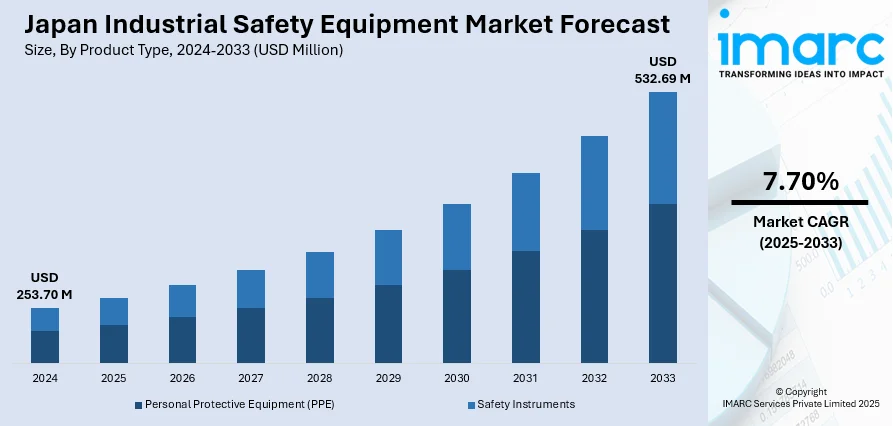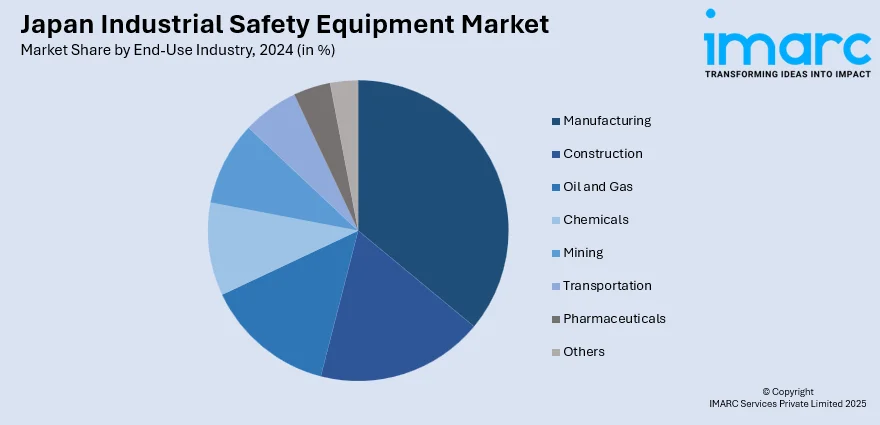
Japan Industrial Safety Equipment Market Size, Share, Trends and Forecast by Product Type, End-Use Industry, and Region, 2025-2033
Japan Industrial Safety Equipment Market Overview:
The Japan industrial safety equipment market size reached USD 253.70 Million in 2024. Looking forward, IMARC Group expects the market to reach USD 532.69 Million by 2033, exhibiting a growth rate (CAGR) of 7.70% during 2025-2033. At present, Japan is consistently reinforcing workplace safety regulations and standards that are driving the demand for industrial safety gear. Moreover, rapid technological innovations and the heightened demand for safer and smarter safety solutions are impelling the market growth. Additionally, the growing emphasis on worker health and wellness is expanding the Japan industrial safety equipment market share.
|
Report Attribute
|
Key Statistics
|
|---|---|
|
Base Year
|
2024
|
|
Forecast Years
|
2025-2033
|
|
Historical Years
|
2019-2024
|
| Market Size in 2024 | USD 253.70 Million |
| Market Forecast in 2033 | USD 532.69 Million |
| Market Growth Rate 2025-2033 | 7.70% |
Japan Industrial Safety Equipment Market Trends:
Enhanced Workplace Safety Laws and Regulations
Japan is consistently reinforcing workplace safety regulations and standards that are highly driving the demand for industrial safety equipment. The Government is constantly revising occupational safety legislation to provide a secure working environment in different industries, especially manufacturing, construction, and energy industries. Firms are proactively responding to these more stringent regulations by making significant investments in high-quality safety equipment like personal protective gear (PPE), fall protection systems, and hazard detection equipment. With these regulations changing over time, companies are going to be more inclined toward sophisticated safety solutions to stay compliant, reduce risks, and safeguard workers from workplace accidents and injuries. This ongoing commitment to enhancing workplace safety is motivating both large enterprises and small-to-medium-sized enterprises (SMEs) to prioritize and allocate substantial budgets for acquiring safety equipment. In 2024, HACARUS unveiled a new AI tool jointly developed with Tokyo Electron to prevent industrial hazards. This new tool was showcased at the Smart Factory EXPO, where visitors were allowed to experience the technology in action.

To get more information of this market, Request Sample
Technological Advancements in Safety Equipment
Rapid technology innovations and the heightened demand for safer and smarter safety solutions is impelling the Japan industrial safety equipment market growth. Safety equipment manufacturers are adopting advanced technologies like Internet of Things (IoT), artificial intelligence (AI), and smart sensors into safety equipment, which enables real-time monitoring, data gathering, and predictive analysis. For instance, smart helmets, wearable technology, and safety goggles are being fitted with sensors that can identify possible threats such as toxic gas or dangerous temperature extremes. Such technologies are providing better protection and giving workers instant notifications and remote monitoring features. Businesses are constantly trying to incorporate these sophisticated systems into their safety mechanisms to enhance operational effectiveness and promote workers' health. This ongoing evolution of more intelligent, more intuitive safety solutions is propelling the growth of the market in Japan. In 2024, Toyota Material Handling Japan (TMHJ), a subsidiary of Toyota Industries Corporation, in collaboration with Fujitsu Limited (Fujitsu), declared the joint creation of Japan's first service for examining forklift safety. The AI Forklift Driving Assessment service analyzes forklift driving safety in the cloud, merging TMHJ's logistics knowledge with the Fujitsu Kozuchi AI service on Fujitsu Data Intelligence Paas. This service can be accessed via TMHJ's FORKLORE, a range of IOT subscription services designed for logistics locations.
Increased Interest in Worker Health and Welfare
The heightened emphasis on worker health and wellness is offering a favorable market outlook. As awareness of physical and mental health hazards in high-risk sectors like construction, mining, and manufacturing increases, companies are investing in equipment that not only prevents accidents but also enhances overall worker well-being. With industries giving more importance to ergonomics, fatigue control, and health surveillance, there is a constant need for safety products to enable these efforts. For example, ergonomic workstations, anti-fatigue matting, and higher-level respiratory protection equipment are becoming more popular. Moreover, organizations are consistently adding wellness programs in addition to safety solutions to ensure long-term employee health benefits. This increase in investment in complete worker well-being is driving the market for safety equipment, promoting the use of products that extend beyond conventional protective gear to the totality of health and comfort in the workplace.
Japan Industrial Safety Equipment Market Segmentation:
IMARC Group provides an analysis of the key trends in each segment of the market, along with forecasts at the country and regional levels for 2025-2033. Our report has categorized the market based on product type and end-use industry.
Product Type Insights:
- Personal Protective Equipment (PPE)
- Head Protection
- Eye and Face Protection
- Hearing Protection
- Respiratory Protection
- Hand Protection
- Protective Clothing
- Foot Protection
- Safety Instruments
- Safety Sensors
- Safety Controllers/Relays
- Safety Valves
- Emergency Shutdown Systems (ESD)
- Fire and Gas Monitoring Systems
- High Integrity Pressure Protection Systems (HIPPS)
- Burner Management Systems (BMS)
The report has provided a detailed breakup and analysis of the market based on the product type. This includes personal protective equipment (PPE) {head protection, eye and face protection, hearing protection, respiratory protection, hand protection, protective clothing, and foot protection} and safety instruments {safety sensors, safety controllers/relays, safety valves, emergency shutdown systems (ESD), fire and gas monitoring systems, high integrity pressure protection system (HIPPS), and burner management systems (BMS)}.
End-Use Industry Insights:

- Manufacturing
- Construction
- Oil and Gas
- Chemicals
- Mining
- Transportation
- Pharmaceuticals
- Others
A detailed breakup and analysis of the market based on the end-use industry have also been provided in the report. This includes manufacturing, construction, oil and gas, chemicals, mining, transportation, pharmaceuticals, and others.
Regional Insights:
- Kanto Region
- Kansai/Kinki Region
- Central/ Chubu Region
- Kyushu-Okinawa Region
- Tohoku Region
- Chugoku Region
- Hokkaido Region
- Shikoku Region
The report has also provided a comprehensive analysis of all the major regional markets, which include Kanto Region, Kansai/Kinki Region, Central/ Chubu Region, Kyushu-Okinawa Region, Tohoku Region, Chugoku Region, Hokkaido Region, and Shikoku Region.
Competitive Landscape:
The market research report has also provided a comprehensive analysis of the competitive landscape. Competitive analysis such as market structure, key player positioning, top winning strategies, competitive dashboard, and company evaluation quadrant has been covered in the report. Also, detailed profiles of all major companies have been provided.
Japan Industrial Safety Equipment Market Report Coverage:
| Report Features | Details |
|---|---|
| Base Year of the Analysis | 2024 |
| Historical Period | 2019-2024 |
| Forecast Period | 2025-2033 |
| Units | Million USD |
| Scope of the Report |
Exploration of Historical Trends and Market Outlook, Industry Catalysts and Challenges, Segment-Wise Historical and Future Market Assessment:
|
| Product Types Covered |
|
| End-Use Industries Covered | Manufacturing, Construction, Oil and Gas, Chemicals, Mining, Transportation, Pharmaceuticals, Others |
| Regions Covered | Kanto Region, Kansai/Kinki Region, Central/ Chubu Region, Kyushu-Okinawa Region, Tohoku Region, Chugoku Region, Hokkaido Region, Shikoku Region |
| Customization Scope | 10% Free Customization |
| Post-Sale Analyst Support | 10-12 Weeks |
| Delivery Format | PDF and Excel through Email (We can also provide the editable version of the report in PPT/Word format on special request) |
Key Questions Answered in This Report:
- How has the Japan industrial safety equipment market performed so far and how will it perform in the coming years?
- What is the breakup of the Japan industrial safety equipment market on the basis of product type?
- What is the breakup of the Japan industrial safety equipment market on the basis of end-use industry?
- What is the breakup of the Japan industrial safety equipment market on the basis of region?
- What are the various stages in the value chain of the Japan industrial safety equipment market?
- What are the key driving factors and challenges in the Japan industrial safety equipment market?
- What is the structure of the Japan industrial safety equipment market and who are the key players?
- What is the degree of competition in the Japan industrial safety equipment market?
Key Benefits for Stakeholders:
- IMARC’s industry report offers a comprehensive quantitative analysis of various market segments, historical and current market trends, market forecasts, and dynamics of the Japan industrial safety equipment market from 2019-2033.
- The research report provides the latest information on the market drivers, challenges, and opportunities in the Japan industrial safety equipment market.
- Porter's five forces analysis assist stakeholders in assessing the impact of new entrants, competitive rivalry, supplier power, buyer power, and the threat of substitution. It helps stakeholders to analyze the level of competition within the Japan industrial safety equipment industry and its attractiveness.
- Competitive landscape allows stakeholders to understand their competitive environment and provides an insight into the current positions of key players in the market.
Need more help?
- Speak to our experienced analysts for insights on the current market scenarios.
- Include additional segments and countries to customize the report as per your requirement.
- Gain an unparalleled competitive advantage in your domain by understanding how to utilize the report and positively impacting your operations and revenue.
- For further assistance, please connect with our analysts.
 Request Customization
Request Customization
 Speak to an Analyst
Speak to an Analyst
 Request Brochure
Request Brochure
 Inquire Before Buying
Inquire Before Buying




.webp)




.webp)












